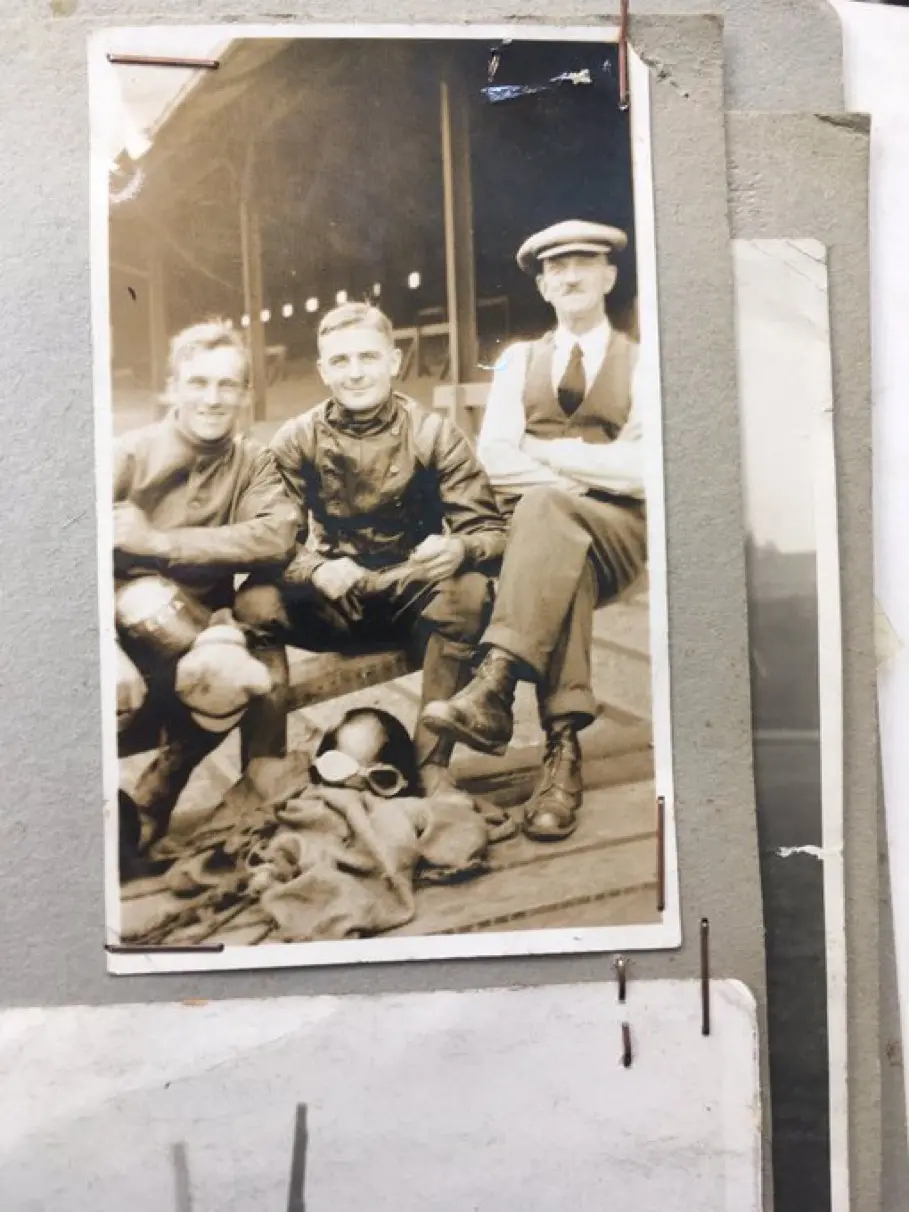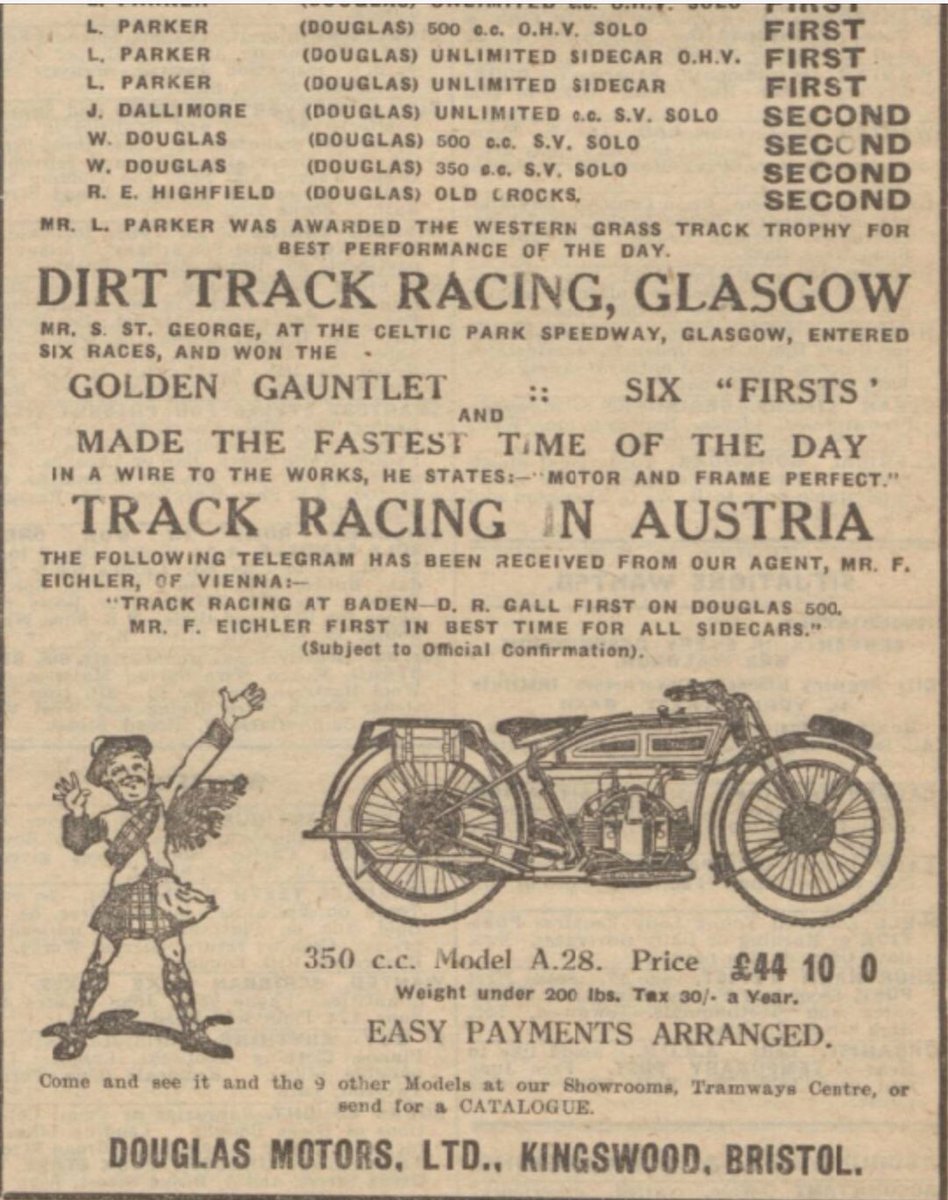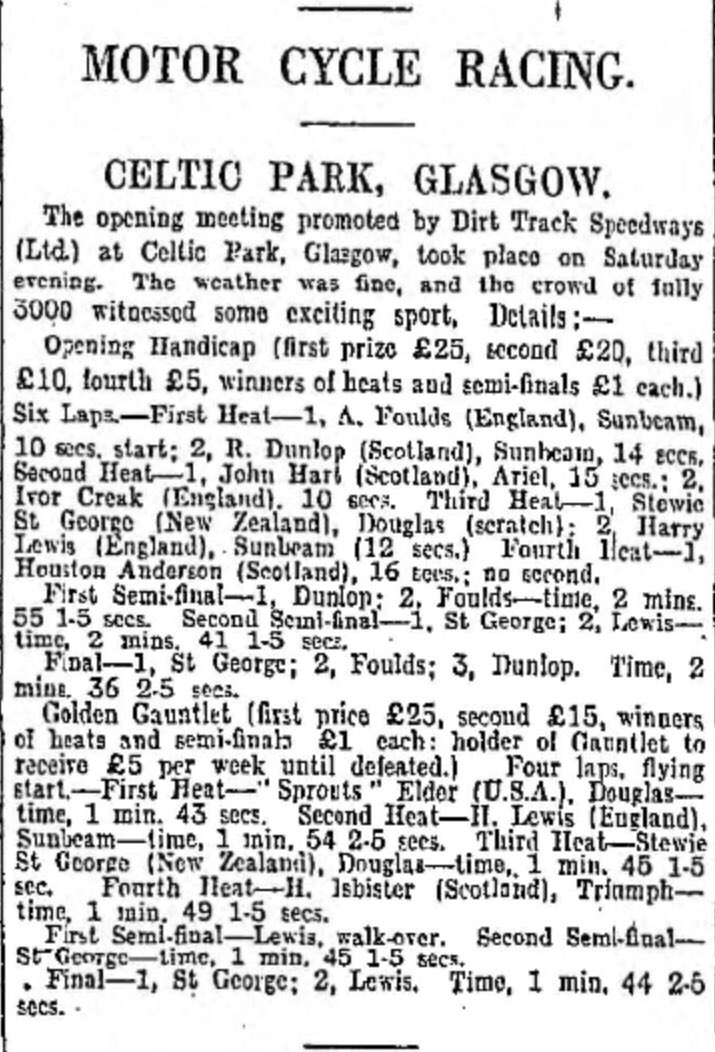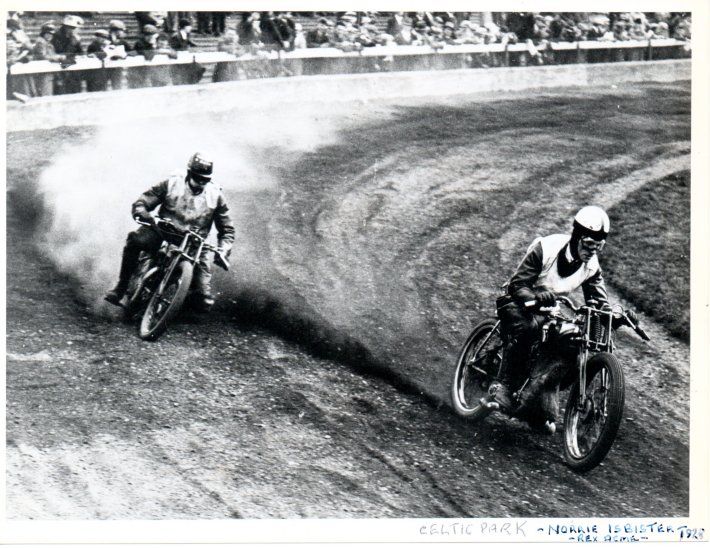Other Sports at Celtic Park | Celtic Park
Background

They followed the April meeting with an exhibition of speedway racing during the interval of the Glasgow Charity Cup tie with Rangers on May 5th. The promotion, Dirt Track Speedways, staged the first charity speedway meeting in the UK raising funds for a new St Andrews Ambulance HQ.
Celtic Park according to speedway historians was used 12 times as a venue (from end April 1928 to late July 1928), with a cracking photo of a rider coming off and the crowd ducking for cover from the dust, the rider is named as Johnnie Walker, photo below.
Notably the stadium at one time did feature a concrete track round the playing pitch used for various events including a demonstration of motorcycle time trials in 1910.
Riders though were not happy with the surface and the venue was changed to (another) Celtic Park! There was a track nearby in around Janefield St which in speedway circles also carried the name “Celtic Park”, but as the photo below shows, speedway did take place inside the stadium
Interest soon waned for the sport, however speedway still has a cult following in Glasgow, and on around the 80th anniversary, a photo call commemoration was made on 29th April 2008 at Celtic Park by the city’s speedway team the Glasgow Tigers.
1928: Johnny Walker crashes inside the Celtic End, not behind it
External Links
Articles
Speedway historian, Jim Henry, writes in his book “Glasgows Speedways – the pre war years” —
“The birth of speedway in Scotland is often the subject of debate and, if you demand that the track be of the cinder variety in a proper stadium, then Celtic Park is the one you should support.
If you want the proto-speedway venue then I must direct you to a stadium which lay to the north of Celtic Park, separated from it by a railway embankment, and marked on the ordnance survey maps of the day as The Olympic Stadium. A somewhat pretentious name for a trotting and greyhound track which was, to describe it best, somewhat egg-shaped. The straights were straight, but the bends were of different radii. The distance round one lap measured at 486 yards. Vertical railway sleepers served as an outside fence and a post and rail fence marked the inner boundary.
From contemporary maps of the track the stadium was orientated with the long axis NNE – SSW and appeared to have some form of covered accommodation at the northern end, adjacent to the bend with the greater radius. The southern bend was adjacent to a railway embankment which in turn was adjacent to the north western terracing (the Celtic End) of Celtic Park. The site is now occupied by the houses of Dalserf Street. This venue which had the postal address of Porter Street, Camlachie was owned by a Mr Nelson and the venue is much better known as Glasgow Nelson. The events staged there were organised by the Glasgow Nelson Motor Cycle Dirt-Track Club, the first such club to be established in Britain.
Activity started in early March 1928, including one on a snow covered track, when the club members took to the track to practice. Jimmy Valente is featured on the front page of the contemporary Sunday Post repairing an inner tube before returning to the track. Further practice sessions were staged and recorded in the contemporary press before the Glasgow lads felt prepared to charge the public to watch what they were up to. The event of 25 March was recorded thus. ‘Thrills in plenty were given by the members of the recently formed Motor Cycle Dirt-Track racing company at Nelson Grounds, Camlachie, Glasgow yesterday afternoon, when both solo and combination machines took part in a number of displays. The attendance must have been most gratifying to the promoters, over 2,000 being present. Exhaustive alterations which are being made are rapidly nearing completion.’
On Easter Monday, 9 April 1928, the doors were opened to the public and the first event staged. Yet again the press were there to record the action in photographic form. Most newspapers carried action photographs which show the riders cornering with feet on the ‘pegs’. The written coverage elsewhere is sketchy to say the least and most meetings seem devoid of much incident. All of 2,000 turned up to watch the heats and finals of 5 events. John Allan, a road racer from Prestwick is recorded as the first winner of a heat. John won the 350cc heat of the 5 lap event in 2 minutes 37 seconds and by a distance of 40 yards from an A. Dick. John went on to win the final from Andy Marr and George Wilson and win £3. Tom Shearer won the 250cc 10 lap event by a lap to collect a gold medal and £1 taking 5 minutes 46.6 seconds in beating Jimmy Reid . The 600cc event went to another road racer, Manx Grand Prix competitor Harry Potts who defeated George Biagi, a relation of track doctor Carlo, covering 5 laps in 2 minutes 27.5 to win £4. James Edward defeated Graham Morrison and Harry Potts to win the Unlimited event in 2 minutes 20.6 seconds and collect a gold medal plus £3 while Peter Coia had a walk over in the sidecar event after Frank Alexander crashed, gifting Peter the gold medal and £2.
According to Norrie Isbister, Nelson was not really dirt track racing as the track was board hard and it was ridden feet up on the pegs. The contemporary photographs fit Norrie’s description of the event but what he did not mention was that the bikes were in road going trim. No bits taken off here.
The following Saturday but one, 21 April the new sport attracted 1,500 fans. This time Scotty Cumming won the 350cc, Graham Morrison, from Ayr, the Invitation (for the best from the opener), James Edward again won the unlimited as did Peter Coia in the sidecars. The 250cc event was cancelled due to lack of entrants.
The night before Celtic Park opened on 27 April, the event winners were 350cc George Wilson, 600cc Peter James, 250cc Tom Shearer while James Edward retained his Unlimited crown and Peter Coia surrendered his sidecar mantle. The report of this meeting is quite sketchy but a certain Norrie Isbister appears in the published results taking second place in the heats of the 350cc.
Friday 4 May 1928 and meeting four gave victories to the same guys as the week before in both the 350cc and 600cc events. The unlimited event was won by Andy Marr, who was a pioneer who had raced sand tracks. The sidecar fell victim of a paucity of entrants. The 1928 finale for Nelson took place the following Friday and it was a Jimmie Pinkerton benefit night. He raced unbeaten through all his races to win the 350cc, 600cc and the unlimited event. Jimmie was a regular attender at Nelson and would go on to appear at White City’s only meting in 1928 which was the swan song of the Glasgow Nelson Dirt-Track Club.
OK the track may not have provided true speedway, but it was a pioneer venture and it helped bring a few riders into the speedway fold. Today the site is covered by houses which are dwarfed by the stands of Celtic Park. There has been talk of demolishing some of these houses, and, if they do this, there may be the chance to erect some form of memorial to Glasgow Nelson and the pioneers of Scottish Speedway.
The track flickered into life in 1932 when at least one meeting was staged there on Tuesday 17 May. A meeting was staged by the riders known as the ‘Blantyre Crowd’ who were running a track at Motherwell under the Lanarkshire Speedway Club banner. A meeting to be staged on 24 May was advertised in the Daily Record and Mail that day. It advised that 20 riders would take part and that admission was 7d. (approximately 3p). Whether this or any other meetings were held is not known.”






